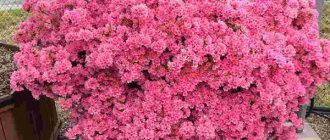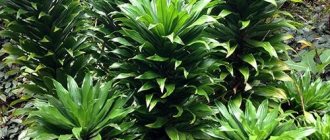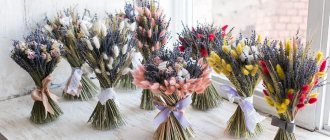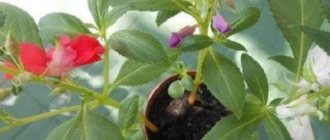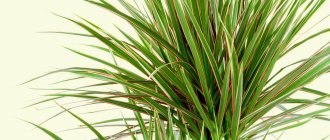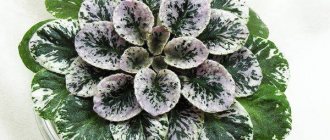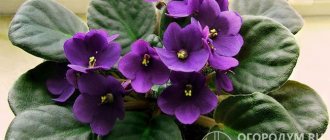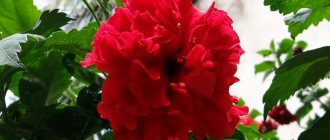The striped leaves of the Derham dracaena will decorate any interior, and everyone dreams of having a nice indoor palm tree. The unpretentious nature of this ornamental plant is also of no small importance. There is nothing complicated about how to care for the Dracaena dereme, you just need to know what it likes. In general, the bush is not capricious and takes root well in almost any conditions. You still need to try to ruin it, and most often this is the result of overzealous care.
Brief description of cultivation
- Bloom. It is grown as an ornamental foliage crop.
- Size. Large size.
- Illumination. In winter, the plant needs a large amount of bright light, and in summer the bush can be placed in slight shade, for example, near a window with a southern or western orientation.
- Temperature conditions. In the warm season - from 18 to 25 degrees, and in the winter months it is recommended to move the plant to a cool place, but the room should not be colder than 12 degrees.
- Watering. During the growing season, it is necessary to water abundantly and systematically. It is necessary to moisten the substrate only after its surface has dried to a depth of 20 to 30 mm. If you provide the dracaena with a cool winter, then you need to water it less often and sparingly.
- Air humidity. The bush must be systematically moistened with a sprayer; you can also periodically give it a warm shower.
- Fertilizer. It is necessary to add a solution of complex mineral fertilizer for decorative deciduous plants to the substrate from April to September once every 15 days. In winter, dracaena does not need fertilizer.
- Rest period. It starts in October and ends in April. However, the plant only enters a dormant state if it is in a cool room.
- Transfer. In spring, at the very beginning of the growing season, but only when necessary (on average, once every 2 or 3 years).
- Reproduction. Seeds, apical cuttings and pieces of stem.
- Pests. Thrips, aphids, mealybugs, scale insects and spider mites.
- Diseases. Alternaria, phyllostictosis or light brown spotting.
Growing conditions
As already mentioned, Dracaena Derema came to us from the warm subtropics and that is why it absolutely cannot tolerate low temperatures. During the period of its active growth, the air temperature in the room should not fall below 21-26 degrees. At temperatures below 21 degrees, dracaena slows down its growth. In winter, a drop to 18 degrees is allowed. At temperatures below 12 degrees, dracaena becomes severely hypothermic and may die.
Light diffused light is considered ideal lighting for Dracaena dereme. If there is not enough light, she may get sick, and if she is exposed to direct sunlight, she may get burns. If possible, in the summer it is recommended to take it out onto the balcony, but make sure that it is not exposed to bright light and there are no drafts.
Usage
Dracaena Sandera shoots sold under the name Lucky Bamboo
Some types of dracaena secrete a blood-red resinous juice, the so-called “dragon's blood”. Since ancient times, it has been used in dried form in Mediterranean countries for medicinal purposes and also as a dye; in India it was used in religious ceremonies. About the existence of a tree that grows on the island of Socotra and from which you can get dragon's blood (the modern scientific name of this plant is Dracaena cinnabari
), was known to Dioscorides in the 1st century AD.
Dragon's blood as from the Canarian dragon tree ( Dracaena draco
), and from the Socotra dragon tree (
Dracaena cinnabari
) are traditionally obtained by tapping.
It has neither odor nor taste, and is soluble in acetic acid and other organic solvents. Its melting point is 70 °C, at 210 °C it begins to decompose. It is used to obtain varnish for metal surfaces, in folk medicine, and also for tinting wines; in the Canary Islands in prehistoric times it was presumably used for embalming; contains pigments dracocarmine and . In China, "dragon's blood" usually refers to the resin extracted from Dracaena cochinchinensis
; in traditional Chinese medicine it is used to improve blood circulation in the treatment of various injuries, as well as for congestion and various pains.
Derema dracaena (Dracaena Deremensis)
This type of palm tree is a slow-growing, low-growing plant native to tropical Africa. In nature, it grows up to five meters. When grown indoors, it does not reach even one and a half meters. It is characterized by a thick, upright growing trunk, which becomes lignified after several years and is covered with decorative leaves up to a meter long and up to half a meter wide. The leaves are sessile, elongated, sword-shaped, shiny, and bend downward as they mature. It is considered the tallest representative of this species. Growing up to three meters at home. The stem of the palm tree is thick, not branched, and does not grow lateral branches. The leaves have a tricolor color, which is why the entire palm tree takes on a very decorative appearance.
Under ideal growing conditions, Derema dracaena blooms with beautiful dark red flowers with a snow-white center, which have a strong unpleasant odor. When growing, you should regularly wipe the leaves of the plant and also irrigate them, since the flower does not react well to dust. Derema dracaena is a heat-loving plant and likes to be grown at a temperature of 20-22 degrees. It is propagated using cuttings, which take root within one and a half to two weeks, and when using rooting preparations, the cutting grows roots within a week.
When and how does it bloom
Dracaena marginata - how to plant and care
In indoor conditions it blooms no more than once every 8-11 years.
Types of flowers
The flowers are small in size - from 1 to 3 centimeters in diameter. The petals are painted white. During flowering, the buds emit an unpleasant odor.
Flower shapes
Small buds are located on the inflorescences in the shape of a brush. There are from 10 to 20 flowers on a long peduncle.
Flowering period
The plant practically does not bloom, which is why the period of blooming of its buds can fall at any time during the growing season.
How to replant dracaena
Dracaena should be replanted at the beginning of a new growth cycle - in spring, early summer. Young plants need to be replanted annually, as plants grow vigorously, quickly using up nutrients. Old dracaenas (over 6-7 years old) can be replanted every two to three years.
It is better to compose the soil for dracaena yourself from various components: 1 part turf soil, 1 part leaf soil, 1 part rotted manure (compost) and 1 part coarse sand (more precisely, fine gravel 3-4 mm in size).
If you use soil for dracaenas from a store, choose trusted manufacturers (for example, Terra Vita Living Earth). But to such soil it is advisable to add 1/5 of the volume of fine gravel or coconut shavings (chips) and the same amount of compost (humus). But in any case, the soil must be sterilized.
The root system of dracaenas is relatively small and rather superficial; it does not tolerate waterlogging, so the pot has high drainage. You can plant dracaenas in purchased soil for palm trees and other large plants, or in universal soil. However, it is a good idea to add loosening elements (fine gravel, coconut substrate) to such soil in an amount of 1/5 of the volume of the pot.
Special care requirements for dracaenas
Dracaenas are very sensitive not only to chlorine contained in tap water, but also to elements such as fluorine and boron.
To get rid of chlorine, just let the water sit for 24 hours. However, if there is an excess of fluoride in tap water in your area, settling will not help; filtering reduces its content to some extent, but only slightly. Only filters with reverse osmosis are better at purifying water from this chemical element. If you do not have such a filter, the best solution would be to water the dracaenas with distilled water.
In addition, it is important to avoid fertilizers and soils containing superphosphates - they have a high fluorine content. Perlite and vermiculite are also prohibited for dracaenas - they contain high levels of fluoride
Acidity is also important, so that plants do not get fluoride poisoning, maintain the soil pH in the region of 6-6.5 units (the amount of fluoride bound by the soil increases as the pH decreases). When the acidity pH is below 6.0, dracaena may experience leaf spotting, necrosis of the tips and edges of leaves - a deficiency of Potassium, possibly simultaneously with the accumulation of fluoride. Sometimes these are single brown spots located closer to the edges. At a pH above 6.5, iron deficiency occurs and appears as chlorosis, primarily on young leaves.
How to properly form a beautiful flower crown
How dracaena blooms - what types, proper care
Dracaena Deremenskaya grows with one even trunk and reaches a considerable height. In this case, the leaves on the long trunk gradually fall off, leaving only the top. The plant becomes unkempt.
Dracaena can reach a height of one and a half meters
To get a beautiful, branched flower, you need to trim it in time. If the tree has reached a height of at least 30 centimeters, you can begin this operation.
At the point where the leaves emerge, it is necessary to make an even horizontal cut. Cover the trunk with paraffin or film to prevent the plant from drying out. After a while, the dormant buds will begin to sprout.
Reproduction methods
The question of how to propagate dracaena sooner or later arises for everyone who decides to grow it at home. It is permissible to reproduce at almost any time of the year, but it is better to choose spring and summer. In winter, you will have to slightly increase the temperature in advance, provide additional lighting and watering.
Reproduction is carried out:
- cutting off the top part and then rooting it;
- air layering;
- stem cuttings;
- seeds.
Seeds
It is easy to find seeds of many types of dracaena on sale. In nature, it blooms at the age of 10-25 years, at home - extremely rarely. In greenhouse conditions, sometimes the flowering of fragrant dracaena, reflexum, draco is observed, and Dracaena exudes an unpleasant odor during flowering. To obtain seeds, pollination is carried out with a soft brush. After receiving the fruits (fruits are not always formed), they are cleared of pulp and sown in a moist soil mixture - it is recommended to buy special soil.
Planting is done to a depth of one cm, drainage is required. It is better to sow in March-April, cover the container with film, glass, and place it in the warmest place - 27-29 degrees, preferably with heating from below. Germination occurs within 40-170 days, during which time the soil must be moist. When the seedlings grow four to six cm high, they are transplanted into separate small pots. Now the plants can be placed in cooler conditions - 22-24 degrees.
Stem cuttings, top cuttings
How to propagate dracaenas by cuttings:
- you will need a very sharp knife, which must be pre-treated with alcohol;
- then the plant is cut five to seven cm from the beginning of the trunk;
- the cut off top is placed in a glass of water, changing it twice a week - you need to wait until the roots appear, and then transplant it into a pot with soil mixture or plant it in the ground immediately after trimming;
- in the latter case, the length of the cutting is made at least five cm, you can even remove several lower leaves;
- the lower part of the stem is sprinkled with root powder; for the first time a very small pot is suitable - with a diameter and a depth of no more than 10 cm;
- the cutting is inserted into the dug hole, pressed lightly, you can place the plant under a transparent plastic or glass cap;
- the first two to three weeks it is necessary to ensure a temperature of about 26 degrees, frequent watering, spraying if the air in the room is dry;
- Spraying and watering are carried out only with water at room temperature.
The stump remaining after pruning should be smeared with garden varnish or sprinkled with charcoal - even a pharmaceutical activated one will do. It is also covered with a glass cap on top, waiting for new shoots to appear.
Another method is stem cuttings, which is usually used only when the apical part has rotted or dried out. The living, non-flaccid part of the trunk is cut with a sharp knife along the leaf scars, into pieces 4-15 cm long. Rooting is allowed in sand, perlite, suitable soil mixtures, sphagnum moss, vermeculite. With horizontal rooting, the cuttings are placed on moist soil, slightly pressing into it; with vertical rooting, a layer of sand about 6 cm thick is poured on top of the soil, and the cutting itself is inserted there to a depth of two to three cm.
Reproduction methods
Due to the fact that Dracaena compacta practically does not bloom at home, and side shoots appear infrequently, its propagation is carried out by cuttings. To do this, the top of the “mother” plant is cut off by 10 or 15 centimeters and placed in water at room temperature, in which one tablet of activated carbon has already been dissolved. The first roots appear on the cuttings a week after pruning.
However, there are other ways to root cuttings. So, instead of water with coal, you can use:
- a mixture of ground coal with sand and peat;
- vermiculite or perlite - something that will be easier for the grower to purchase;
- special soil for dracaenas or, if it was not possible to find it, soil for the palm family, which was well steamed before this.
Such methods are less popular among gardeners, but it is believed that propagating cuttings in this way makes their root system stronger.
As soon as the root system of the cuttings has grown sufficiently, they can be planted in the ground. It is recommended to plant several cuttings in one pot at once, close to each other. In the future, this will add splendor and beauty to such a bush.
Do not forget that dracaena should be propagated only during the period of active growth, that is, in spring and summer. If you start this process in autumn and winter, there is a high probability that the cuttings will simply die.
It is recommended to cut the cuttings with a sharp knife, but under no circumstances break off the top with your hands. Such a harsh impact can lead to the death of both plants.
To learn how to care for Dracaena compacta at home, see the following video.
Features of care in winter, rest period
Dracaena - home care and growing in a pot
During the dormant period, almost all care activities are reduced. Watering is carried out only when absolutely necessary, and fertilizing is stopped altogether. Occasionally you need to spray the plant, as in winter due to heating the air in the room becomes dry.
Dracaena flowering is a rare occurrence
Care
Caring for dracaena at home is not so difficult. It grows quickly, so timely pruning is required unless you want to have a tall palm tree. The grower will need to monitor the tree for spider mites, which live and feed primarily on the underside of the foliage. To remove them, it is not necessary to use chemicals, just put the flower in the bath and rinse the leaves under high pressure of water, for example, using a shower.
Temperature and humidity
The described plant does not like the cold, as it is accustomed to a tropical climate. His homeland is the Canary Islands. For this reason, in the room where the dracaena is located, the temperature should never drop below 10°C. If this condition is not met, the foliage will begin to rot and the tree itself will die.
When moving a plant outside for the summer, it is worth remembering that at night the air temperature should not fall below the specified level, because even a slight frost will kill the tree. The temperature range for ideal growth is between 16°C – 24°C.
The plant has special requirements for humidity, so the grower must strictly monitor this parameter. The soil should remain moist, but not wet, as this will cause the roots to rot. Dracaena can withstand short-term drought, but it cannot withstand waterlogging. Reduce watering in winter, since during this period much water is not required for growth.
Reasonable humidity in the room is needed, since sometimes it becomes noticeable that brown spots appear on the foliage, which are the flower’s reaction to non-compliance with the conditions of maintenance. For this particular plant, this figure ranges from 60 to 100%.
Lighting
Dracaena loves light and warmth, but does not like to be in direct sunlight, since in its natural environment it grows under the shade of taller tropical trees. The ideal room is where it is light most of the day, but the lighting is diffuse. A window sill on the north side of the house works well. You can also place a pot in the south, but place it so that the sun does not hit the tree, otherwise spots will appear on the foliage.
Fertilizer
As for the soil used, there is nothing special, the described plant only needs to dry it well and use a pot with drainage holes to prevent root rot. You can add stones to the bottom of the container to prevent the water from stagnating. This and any other variety does not need a large amount of fertilizer, but if you want to promote growth, you can fertilize it once a month during the growth season (spring, summer).
Watering
It is necessary to water the plant when the soil is already dry, and you should take care of good drainage. For irrigation, warm water without fluoride is used, so do not take it from the tap. If you have a well, it is advisable to use water from there or rainwater, which is heated before watering. If there are no such options, then you need to use distilled water.
Water is poured into the pot until it flows out through the drainage holes onto the tray from below. It is drained 30 minutes after watering, when all the excess has already flowed out. If rot and an unpleasant odor appear, this means that the grower moistened the soil too often and the plant began to rot. In this case, you can still help; to do this, you just need to wait until the soil dries out, and subsequently establish the correct soil moisture regime.
Pruning and crown formation
An adult plant must be pruned in a timely manner, thereby forming an attractive crown. Cut off the main stem of the tree if the trunk becomes too tall. Trimming is done to the desired height using scissors. The top can then be planted in the ground and it will germinate, forming a new tree. A bare trunk will develop two or more side branches and new foliage below the cut.
Transfer
It is recommended to replant dracaena every 3 years, and annually it is necessary to change the top layer of soil in the pot. This should be done in the spring in a more spacious pot and nutrient substrate. For good drainage, a layer of expanded clay or small brick chips is covered at the bottom of the container, and the substrate is mixed with river sand.
Drying of the leaf blades of the bush
Appearance of the plant
The calling card of dracaena is not only its lignified trunk, but also its long, pointed, narrow leaves with parallel veins that converge at the tips. As the plant grows, the lower leaves turn yellow and die. Their average life cycle is up to 2 years. Another interesting feature of the family is the roots. They are smooth, straight, and have an unusual orange or dark yellow color. House dracaenas rarely bloom. But if this happens, you can admire the small greenish or white flowers. But keep in mind that most species have a rather unpleasant odor. Dracaena fruits are drupes. The ovary is formed on loose flower panicles.
What does the plant look like?
In appearance, dracaena looks like a small palm tree. Decorative flower native to tropical forests of Africa and southern Asia. A straight trunk can reach one and a half meters or more. It grows slowly.
Dracaena deramensis
The leaves are longitudinal, wide, with variegated lines of white or cream colors. Their shape resembles a boat. The surface needs to be constantly cleaned from dust. Therefore, it is necessary to spray warm water on the plant several times a day and often wipe the surface of the leaves.
Dracaena Deremensis blooms rarely, with small flowers collected in a panicle. Then round, orange fruits form on the peduncles. Flower color: white inside, red outside. They have a pleasant smell. This species is also called fragrant dracaena, or tree of happiness. At home, flowers are the exception rather than the rule.
Attention! The bush cleanses the surrounding air well and has bactericidal properties.
Dracaena will, unnoticed by others, disinfect the atmosphere in the room and help heal wounds in people who are constantly here. The red juice of the trunk is used in Chinese medicine to treat stomach ulcers, blood clots, and skin diseases. The plant calms others and strengthens their immune system.
Dracaena does not require complex care. The leaves die and remain on the trunk. It's always clean. Housewives especially like it for its beautiful appearance and easy care. Therefore, now it can be seen in almost every home. It is easy to care for and easy to propagate.
Attention! It is better to place the flower in reception areas and rest rooms. It is not recommended to place it in a nursery or bedroom.
Varieties of fragrant dracaena
Some believe that dracaena dereme and fragrant are the same variety. Although they are very similar in appearance, they are still completely different representatives of the Dracaena genus. About 20 varieties of fragrant dracaena are cultivated indoors. They all differ in both height and leaf color:
- Compacta
. It is the most common variety. This is a perennial shrub up to 2 m high with thickened stems and a dense dark green crown of long glossy leaves. - Yellow Coast
. One of the tallest indoor varieties, growing up to 2.5 m. The leaves have characteristic stripes of bright green and yellow. - Golden Coast
. A miniature variety up to 1.5 m high with lush rosettes of leathery leaves of a rich green hue. - Massengeana
. A massive shrub with rosettes of long leaves, each with a clearly visible bright yellow stripe in the middle. - Kanzi
. One of the rare varieties. Recognizable by rosettes of rich green leaves, the color of which varies from center to edge from emerald to light green. Each leaf blade is lined with longitudinal white stripes.
What does Dracaena derema look like, what family does it belong to?
Dracaena deremensis is a perennial evergreen plant that belongs to the Agave family. This subshrub has a trunk without side branches, on which leaves are densely located. The plant resembles a clump of foliage growing on the ground. However, as it grows, its trunk can stretch out, and the crown becomes similar to a palm tree. The leaves are sword-shaped, light green in color and have light-colored longitudinal veins.
Dracaena is widely used in the design of various interiors.
Common varieties
Among dracaena varieties, artificially bred hybrids are especially popular. They are highly resistant to disease and frost. These varieties include: Janet Craig, White Stripe (White Stripe), Varneski and Lemon Lime.
Medicinal properties
Dracaena deremensis has the following healing properties:
- improves well-being and relieves headaches, purifies the air in the room;
- relieves stress and nervous conditions;
- increases immunity.
Briefly about the history of appearance
The shrub grows naturally in Africa and East Asia, where it has long been cultivated as a garden plant. In middle and northern latitudes, dracaena is grown in houses and apartments.
Conditions of detention
The soil
Derema Dracaena is undemanding to the soil, but it is important that the soil mixture is of high quality and nutritious. The ideal option would be a mixture of sand and deciduous soil
Adding a small amount of charcoal to the soil will reduce the risk of root rot.
Sometimes you should loosen the soil, increasing the flow of air to the roots, but in winter you should not disturb the plant. The top layer of soil in a container with an adult Dracaena can be renewed two to three times throughout the year.
Lighting
The ideal lighting for a plant is diffused rays. With a lack of light, the leaves of Dracaena Derema may change color and fade. But keeping the plant in direct sun for a long time is even more detrimental to it: burn spots may appear.
In winter, if there is a lack of natural light, Dracaena can be placed under artificial light sources from time to time.
Temperature
In summer, a guest from the tropics feels great at an air temperature of +20 - +26 degrees Celsius. At this time, active plant growth occurs.
In winter, the development process slows down a little. At this time of year, it is permissible to keep Dracaena Deremskaya in a room with a temperature of +15 - +18 degrees. The lower limit is 13 degrees Celsius, otherwise the plant may get sick or die.
Air humidity
Dracaena Deremskaya tolerates insufficient air humidity, but the optimal level for it is a humidity level of about 40-60 percent.
For the best development of the plant, it is necessary to spray it regularly, especially in winter when the central heating is on.
And on summer days it is recommended to pamper the tropical beauty with a warm shower. Dusty leaves can be wiped with a damp sponge.
Watering
Watering the Derema Dracaena should be taken responsibly, since on the one hand, it does not like dry soil - its top layer must be constantly moistened, and on the other hand, waterlogging can destroy the plant.
To avoid root rotting, you must make sure there are holes in the Dracaena container. In winter, the amount of watering should be reduced, allowing the soil to dry out a little.
Transfer
In winter, the development of the plant is not intensive, and with the onset of spring its active growth begins. This is the time that is ideal for transplanting into a container increased by two to three centimeters in diameter.
Reproduction
Dracaena Derema is propagated by cuttings in the spring. To do this, trim the plant with a sharp knife, no shorter than ten centimeters.
It is important that the cut is even, otherwise the cutting may dry out and not take root.
You should also know that before the roots appear, the plant will receive nutrients from the leaves, so you need to choose a young and healthy plant for propagation. The resulting cutting is placed in settled water at room temperature or moistened sand and wait for roots to appear.
The process is quite lengthy: about two months. To speed it up by 10-12 days, you can purchase and add a special rooting agent to the water. If water is used for rooting, it must be changed about twice a week, as it gets dirty.
After the roots appear, the young Dracaena can be planted in the prepared pot.
Possible problems in cultivation and diseases
Dracaena derema is a species that is not highly resistant to disease, and it is often attacked by insect pests.
Drops buds and leaves
Leaves droop and begin to fall due to lack of moisture and nutrients in the soil. It is worth feeding and watering the plant regularly.
The leaves are turning pale
The bush begins to fade when it lacks fertilizer and sunlight. The lack of iron is especially affected, which can be solved by spraying the bush with a solution of iron sulfate.
The tips of the leaves are drying out
The edges of the sheet plates will dry out due to prolonged exposure to the bright sun. On hot sunny days, it is worth moving the pot with dracaena away from the window and into the interior of the room.
The lower leaves fall off
This is how the plant behaves after hypothermia or watering with cold water. You should not allow a sharp drop in temperature, as the plant is heat-loving.
Pests
The following pests cause particular problems for the bush:
- scale insect – the leaves begin to turn black and wither;
- thrips - white dots appear on the front side of the leaves, and on the back the insects themselves are located in the form of black dots;
- spider mite - entwines the plates and stems with a thin web, sucks the juices out of them.
Other problems
If dry spots appear on the leaves, it means the plant has received sunburn. Do not water it during the day in sunny weather or leave it in direct sunlight.
Blooming dracaena is a good omen
Reproduction
Since it is not so easy to get the seeds of this plant, cuttings remain the simplest and most affordable option for propagating dracaena. There are three main ways:
- trunk;
- apex;
- air outlet.
The third among them is the most difficult because it requires attention, care and takes a lot of time. To do this, in the place where the old leaves have fallen off, make an incision, insert a toothpick, put moss, moisten it with water, then wrap it with polyethylene so that the moisture can evaporate from above, and the plant grower can add water from a spray bottle on top. In a few months or less, a separate shoot will appear, which can be transplanted into the ground, where it will feel great and grow.
Most often, they simply cut off the top, which allows not only to change the appearance of the crown on an old plant, but also to get a new, strong and beautiful tree. The planting material is placed with its lower part in a solution with a growth enhancer for several days, and then in moist soil.
Propagation by stem allows you to grow several trees at the same time. To do this, the cut trunk is first dried for several days at room temperature, then cut into pieces. Each should be stuck into the ground with the growth side facing up. Each segment must be at least 3 centimeters in length.
If planting material is planted in soil, it will need to be kept warm and moist, and when trying to root in water, the liquid is changed every day and ensure that it is not cold. After the required number of roots have appeared, the plant is planted in potted compost.
